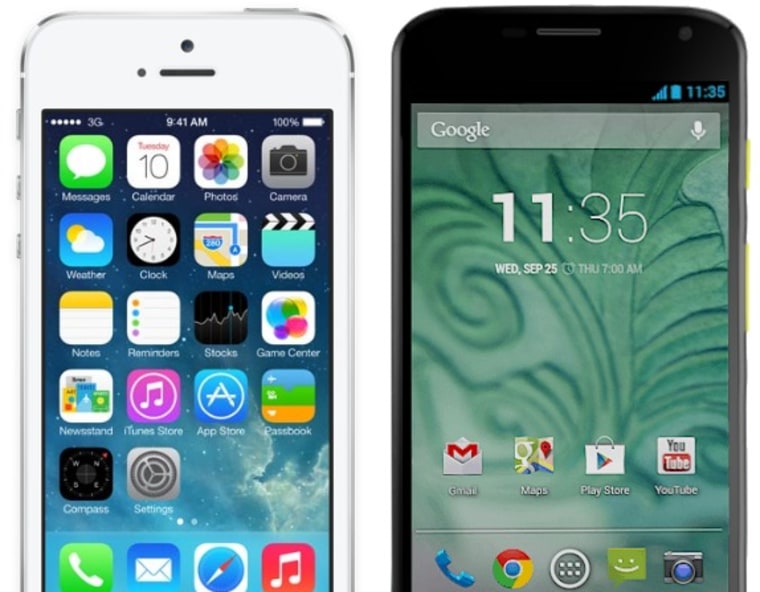The next stage of the smartphone wars has been set with the release of the iPhone 5S, which joins high-end phones like the HTC One, Galaxy S 4, and Moto X for the final battle — of 2013, at least. But in the big competition between iOS and Android, the choice is harder than ever, because the two have never felt more equal to one another.
Once upon a time, Android was the ugly duckling of mobile operating systems. Until recently, manufacturers' skins such as HTC's Sense and Samsung's TouchWiz were necessary to cover up the shortcomings of "vanilla" Android. But starting with Android 4.0 (out in late 2011), Google's core design has actually been better than the overlays — and has the benefit of getting upgraded faster.
As Android matured, iOS started reaching old age. Critics have lately given it flak for its 2007-rooted interface. iOS 7introduced a whole new user experience, and whether you find its frosted glass and pastel theme jarring or delightful, there's no denying that it comes along with a lot of handy new features.
Let's see how the latest versions stack up against one another on a few of the most important points.
Quick settings
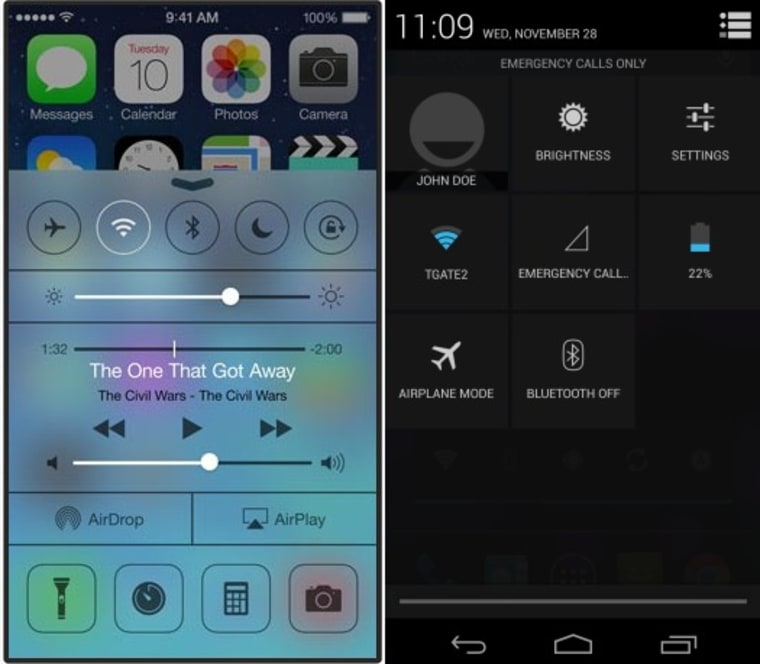
iOS 7 introduced Control Center, which lets you toggle common settings, adjust brightness and control music with a quick swipe up. It's a handy feature — and one Android has had for quite some time. The big difference is that on Android, it comes down from the top rather than up from the bottom, and takes one extra tap to get to. Apple's version is a bit more comprehensive and attractive, but they both accomplish a lot of the same tasks.
Multitasking/App switching
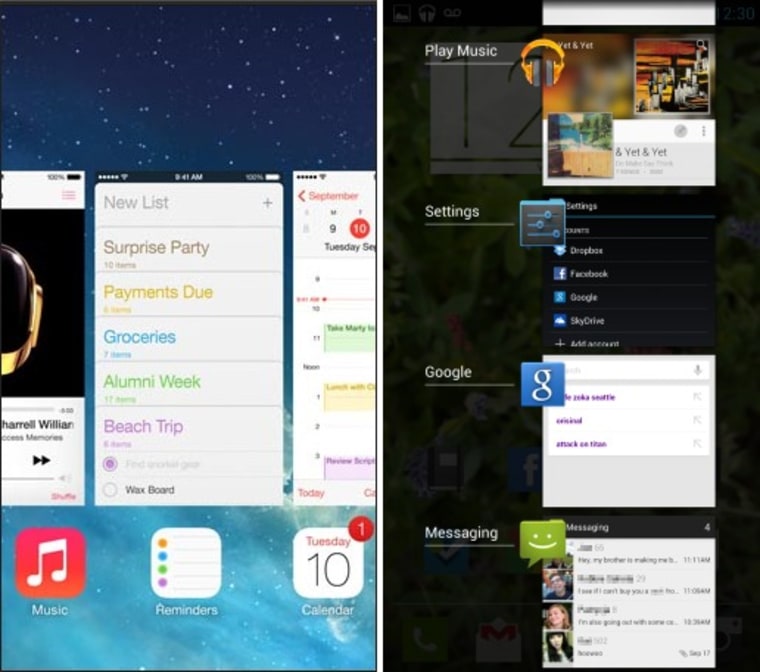
Another feature that Android pioneered and Apple refined in iOS 7 is how you switch between applications. On Android, double tapping the home button brings up a vertical list of apps, with previews of content, such as the last few texts, the state of a game, or a picture you've recently viewed in Facebook.
Apple's version sets up the apps in a left-to-right list instead, and gives the preview far more screen real estate. To "quit" an app, you just flick an app's thumbnail up and away to the top of the screen — a gesture reminiscent of the departed Palm Pre.
Both mobile operating systems have the problem where sometimes switching to and from an app can affect the app itself — reloading a page, aborting a level in a game, deselecting text and so on. When it comes to multitasking, the desktop OS is still king.
Notifications
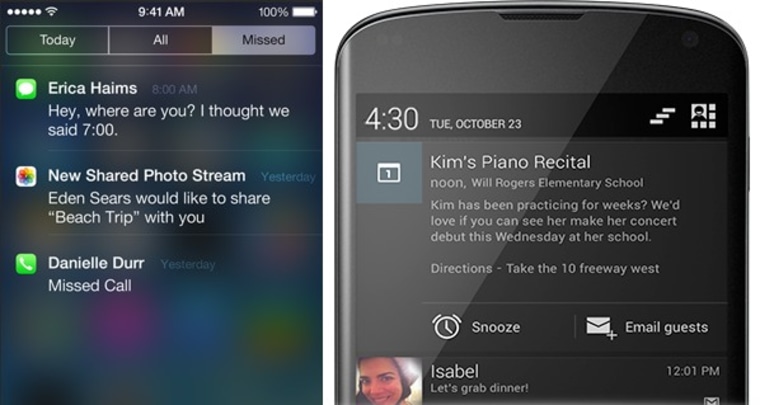
One of Android's strengths has been its rich notification system; pull down the notification drawer, and you're given the latest missed calls, tweets, calendar items, and so on — complete with quick actions like dismiss or reply.
Apple's notifications, lacking for years, have caught up a bit, with more details and categories than before. Unfortunately, quick actions are still missing. On the other hand, the "Today" part of the pulldown drawer takes inspiration from the predictive Google Now, and seems like a great way to start your day: calendar, weather, stocks and so on.
Camera
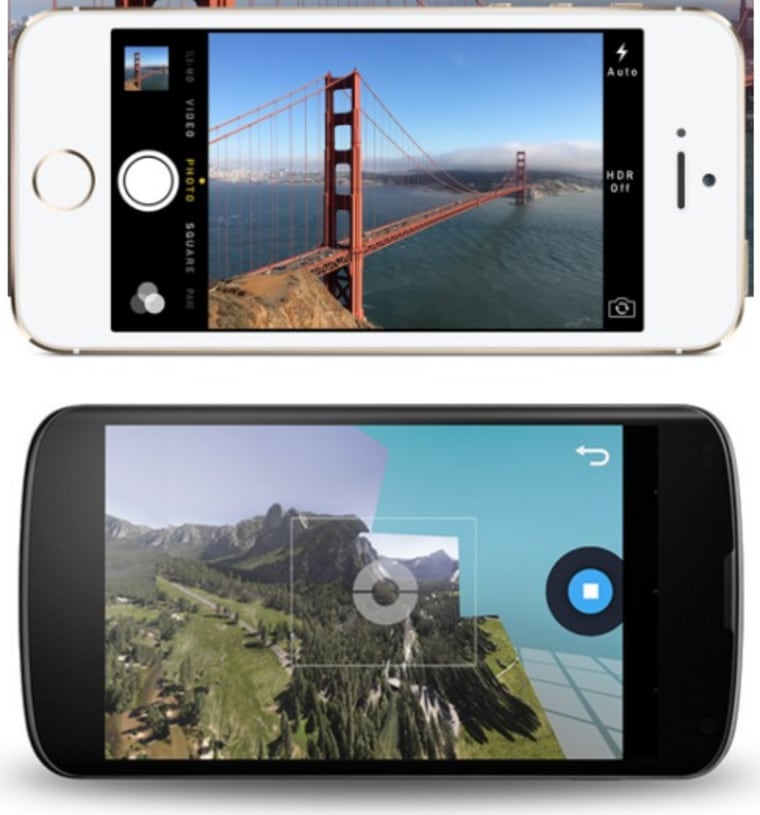
The iPhone's camera has always been a strong point, and the latest devices are no exception. The latest native camera app is clean, versatile and — at least on the iPhone 5S — can even shoot in slow motion. Apple's built-in photo management is also powerful and easy to navigate.
Cameras on Android are, generally speaking, competent but not yet exceptional. Big promises from Samsung and HTC don't always pan out in real-life shots, and the camera apps don't always have great interfaces. Google seems to be hard at work on this, though, and the recent purchase of image-editing service Snapseed probably means good things are on the way.
You can still get great shots on Android, naturally, but the iPhone wins the out-of-the-box experience here for now. Besides, there are also more worthwhile third-party camera apps for iOS than for Android.
Sharing and social
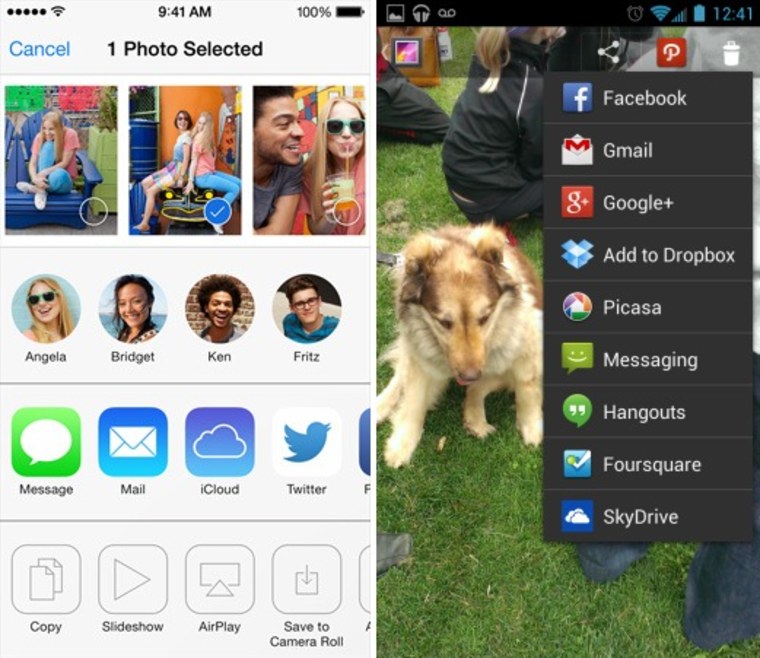
Depending on your typical sharing needs, one OS may suit you more than the other. For instance, if you send things to a few close contacts frequently, iOS's built-in AirDrop, favorite contacts, and tightly integrated Twitter and Facebook options are great.
However, if you want to do a bit more with your files, like share them between multiple apps, back them up to the service of your choice, and move them around more like a desktop OS, Android is still in the lead. But Apple is close on its heels with its new share drawer (shown above), so this could change as apps opt into the native-sharing options.
Music and media
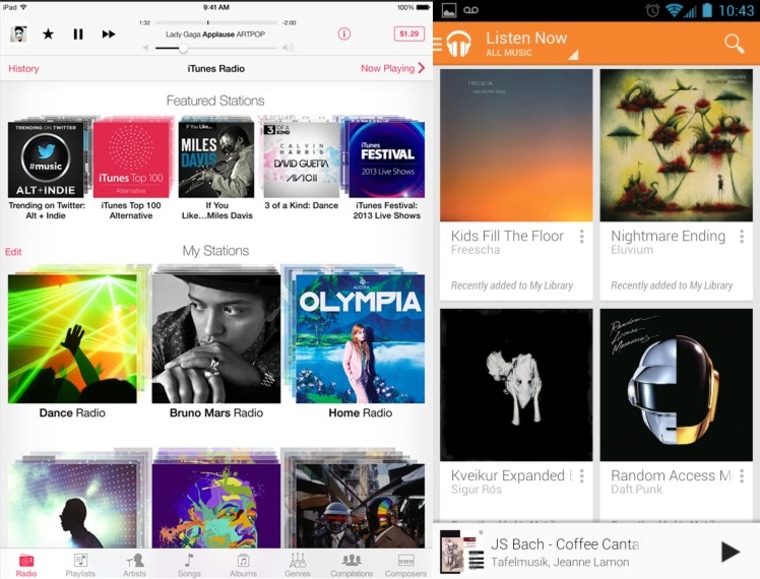
Apple's iPod legacy lives on here, and the music and video functions on iOS are better than ever — and certainly better than Android. The iPhone is still a world-class media device — and the fact that every cool new streaming or music discovery service tends to come out on iOS first can't hurt. iTunes Radio adds to that advantage, too, though you have to be a paying customer to avoid the ads.
Android, unfortunately, lags behind somewhat. Google Music has improved a ton since its clunky early releases, and it's perfectly usable, but the ease and intuitive operation of Apple's devices still eludes its developers.
On the other hand, the super-easy backup and mirroring of your local music is a handy feature for anyone still using local media rather than streaming. And one more point in Google's favor, in video: Android supports more formats out of the box, though you'll be using apps on either platform if you want to play anything more obscure, like FLAC or MKV files.
Hands-free control
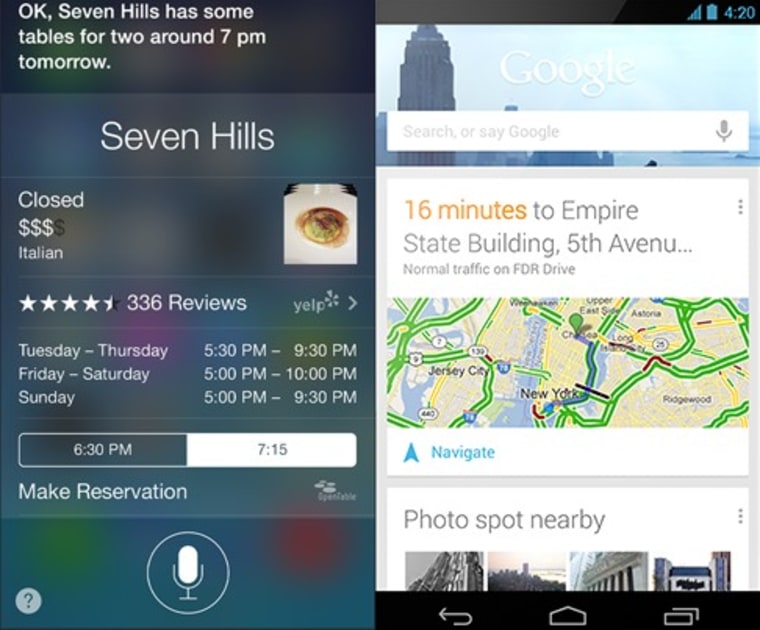
Apple brought voice controls into the limelight with Siri, which was initially impressive but ultimately disappointing. The company has added lots of new controls in iOS 7, though, from better music commands ("What song is playing?") to common phone controls ("Turn on Bluetooth"). Anyone underwhelmed by Siri's first go should give her (or her new male counterpart) another shot.
Google, meanwhile, is doubling down on voice. The new Moto X is listening whether you tap a button or not; just say "OK Google Now" — admittedly kind of a mouthful — and continue with your query: "How many ounces in a cup?" or "What time is my next appointment?"
Both platforms are quickly improving both the accuracy and abilities of their voice assistance engines — only time and careful review will show which is really the better one.
Security/Find my device
Until very recently, Apple's extremely useful "Find My iPhone" service was a major point in iOS's favor. Lost or stolen iPhones could be located, wiped or remotely told to ring loudly — handy when theft of such devices is so common that it has a nickname, "Apple picking."
But Google recently rolled out its Android Device Manager service, which serves the same purpose with a simple Web interface.
While both are capable services, Apple upped the ante again with the iPhone 5S's fingerprint-scanning home button and the ability — in all iOS 7 devices — to lock up lost or stolen device more permanently. For everyday security, Apple is still ahead.
Mobile payments — Google Wallet vs. Apple Passbook
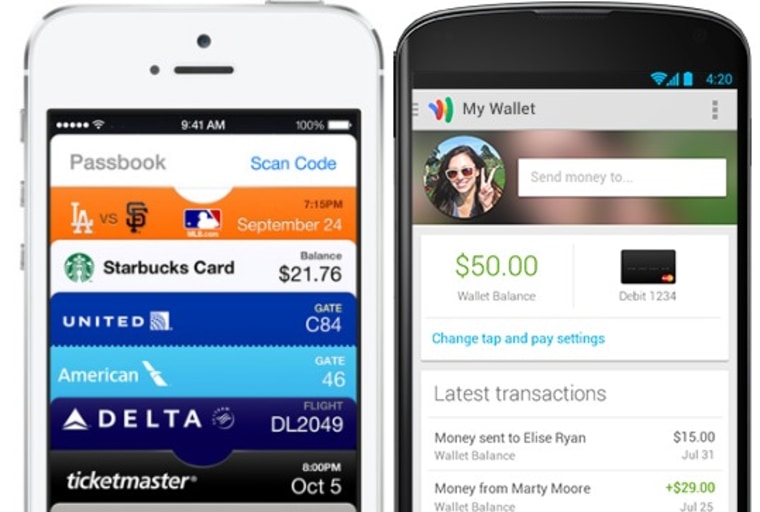
Checking into a flight and paying with your phone can be pretty handy, and right now it's pretty clear that Apple has the edge when it comes to both apps and partnerships. The built-in gift cards and boarding passes may not yet be something you use every single day, but the idea is taking off and Apple is at the forefront.
Google, however, just Tuesday issued a big update to Wallet that adds loyalty cards, easy money transfers, and coupons and offers. (Plus, there's no more requirement for a device to have NFC wireless capability.) It's not the same as Apple's Passbook app (and, at this point, not quite as useful), but this particular rivalry is just beginning.
Final thoughts
Although iOS and Android are extremely competitive in out-of-the-box experiences, we would be remiss not to mention that Android's user experience is very customizable, where iOS 7 is not. You may not be able to add a fingerprint scanner to your HTC One, but you can totally change how the phone looks by using custom icons, widgets, lock screens, and so on. It's one area where Android definitely has the inflexible iOS beat.
But other than that, it's not a clean sweep anywhere. Almost anything you would want to do with a smartphone can be done well on either platform — something that wasn't the case a year or two ago. In the end, choosing one platform over the other comes down to personal preference of devices, and what apps and services you as a user care about the most.
Devin Coldewey is a contributing writer for NBC News Digital. His personal website is coldewey.cc.
